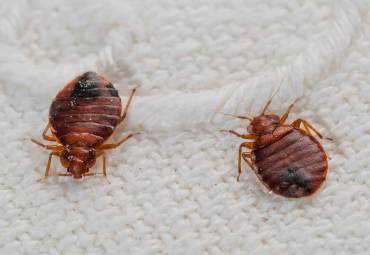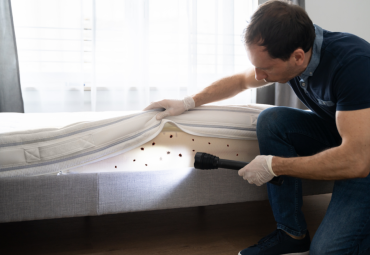Bed bugs are the ultimate nightmare for any homeowner or hotel manager. These pesky pests are notoriously difficult to get rid of, and their bites can leave you with itchy welts for days. If you’re dealing with a bed bug infestation, you’re not alone. Bed bugs are a common problem around the world, and they can be found in even the cleanest and most well-maintained homes. But don’t worry, there is hope! With the right knowledge and treatment, you can eliminate bed bugs from your home or business and get back to a peaceful and restful night’s sleep. In this article, we’ll provide you with expert advice on bed bug treatment, including tips for identifying bed bugs, effective treatment options, and preventative measures you can take to keep them from coming back. So, let’s dive into Bed Bug Treatment 101 and say goodbye to these unwanted houseguests for good!
The first step in treating bed bugs is identifying the problem. Bed bugs are small, brownish-red insects that are about the size of an apple seed. They are most commonly found in mattresses, box springs, and bed frames, but they can also be found in other areas of the home, such as behind baseboards, under wallpaper, or in cracks and crevices. Some common signs of a bed bug infestation include:
– Red, itchy bites on your skin, often in a straight line or cluster
– Small bloodstains on your sheets or pillowcases
– Dark spots on your mattress or furniture, which may be bed bug excrement
– A musty odor in the room, which may indicate a large infestation
If you suspect that you have a bed bug infestation, it’s important to act quickly to prevent the problem from getting worse. Bed bugs can reproduce quickly, and a small infestation can turn into a large one in just a few weeks.
While bed bugs are not known to transmit diseases, their bites can be itchy and painful. In some cases, bed bug bites can cause an allergic reaction, which may result in swelling, redness, and difficulty breathing. Additionally, scratching the bites can lead to a secondary infection. If you have a bed bug infestation, it’s important to take steps to eliminate the problem as soon as possible to prevent further bites and potential health issues.
When it comes to treating bed bugs, there are two main options: DIY treatments and professional services. DIY treatments can be effective if you catch the infestation early and follow the proper steps. However, if the infestation is large or has spread throughout your home, it may be best to seek the help of a professional. Professional exterminators have the knowledge and equipment needed to effectively eliminate bed bugs from your home.
Whether you choose to do a DIY treatment or hire a professional, it’s important to prepare your home for treatment. This includes:
– Removing clutter from the room, including clothing, bedding, and other items
– Vacuuming the room thoroughly, including the mattress and box spring
– Washing all bedding and clothing in hot water
– Sealing any cracks or crevices in the room to prevent bed bugs from escaping
Preparing your home for treatment is an important step in eliminating bed bugs. By following these steps, you can ensure that the treatment is as effective as possible.
If you decide to do a DIY bed bug treatment, there are several steps you can take to eliminate the problem. These include:
1. Vacuuming – Use a vacuum with a HEPA filter to thoroughly clean the room, including the mattress, box spring, and furniture. Be sure to dispose of the vacuum bag outside of your home.
2. Steaming – Use a steam cleaner to treat any areas where bed bugs may be hiding, such as baseboards, furniture, and bedding.
3. Encasing – Use special bed bug encasements to cover your mattress and box spring. This will prevent bed bugs from infesting your bed.
4. Diatomaceous Earth – Apply diatomaceous earth to areas where bed bugs may be hiding, such as cracks and crevices. This natural powder is safe for humans and pets, but it is deadly to bed bugs.
5. Repeat – Repeat these steps every 7-10 days for several weeks to ensure that all bed bugs have been eliminated.
While DIY treatments can be effective, they may not be enough to eliminate a large or widespread infestation. In these cases, it’s best to seek the help of a professional exterminator.
Professional exterminators have access to a variety of treatment methods that are more effective than DIY treatments. Some common professional bed bug treatment methods include:
– Heat Treatment – This involves heating the room to a temperature that is lethal to bed bugs. This method is effective and can eliminate bed bugs in just one treatment.
– Chemical Treatment – This involves using insecticides to kill bed bugs. Professional exterminators have access to stronger and more effective insecticides than those available to the general public.
– Fumigation – This involves sealing the room and using a gas to eliminate bed bugs. This method is typically used in severe infestations.
Professional bed bug treatment can be expensive, but it is often the most effective way to eliminate bed bugs from your home.
Prevention is key when it comes to bed bugs. To prevent future infestations, you should:
– Inspect secondhand furniture before bringing it into your home
– Use bed bug-proof encasements on your mattress and box spring
– Vacuum your home regularly
– Seal any cracks or crevices in your home
– Be cautious when traveling, and inspect hotel rooms for signs of bed bugs
By taking these preventative measures, you can reduce your risk of a future bed bug infestation.
Q: Can bed bugs fly or jump?
A: No, bed bugs cannot fly or jump. They can only crawl.
Q: Can bed bugs live in my hair?
A: No, bed bugs prefer to feed on exposed skin and will not live in your hair.
Q: Can I get rid of bed bugs on my own?
A: Yes, it is possible to eliminate bed bugs on your own, but it may be difficult for large or widespread infestations.
Q: How long do bed bugs live?
A: Bed bugs can live for several months without feeding.
Q: Can bed bugs survive in extreme temperatures?
A: No, bed bugs cannot survive in temperatures above 120°F or below 32°F.
Bed bugs are a common problem, but they can be eliminated with the right knowledge and treatment. Whether you choose to do a DIY treatment or hire a professional exterminator, it’s important to act quickly to prevent the problem from getting worse. By following the steps outlined in this article, you can eliminate bed bugs from your home and prevent future infestations. Remember to inspect secondhand furniture, use bed bug-proof encasements, and vacuum your home regularly. With these preventative measures, you can sleep soundly knowing that your home is free of these pesky pests.








